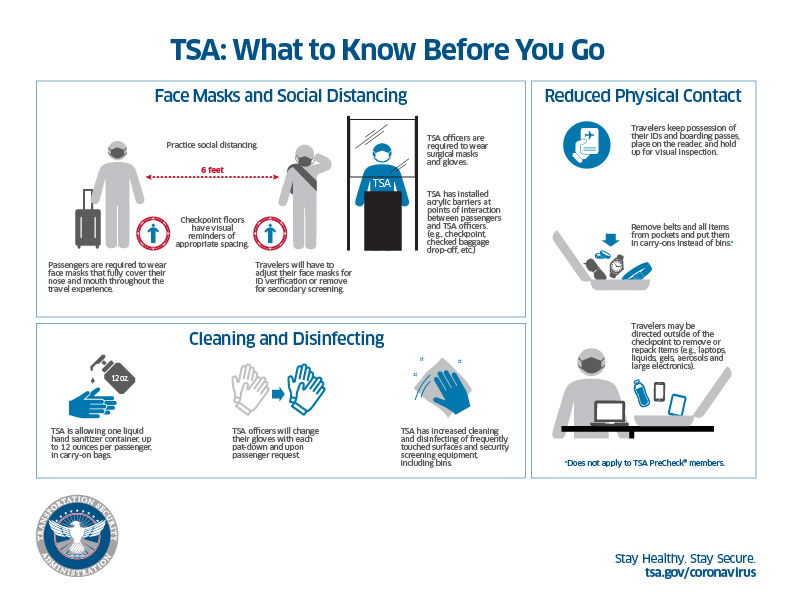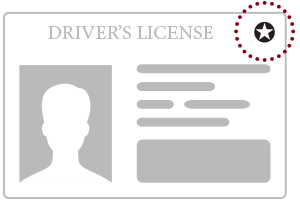SearchSearch
- TRAVEL
- MEDIA
- ABOUT
- CONTACT
- Home
- Coronavirus (COVID-19) information
Coronavirus (COVID-19) information

Updated November 15, 2021
TSA Response to COVID-19
The Transportation Security Administration continues to adjust its security operations during the COVID-19 global pandemic. We established this webpage to provide resources and information to assist passengers who travel during this time. TSA is ready to meet the current and future security needs of the nation’s transportation systems and remains dedicated to keeping travelers and our frontline workforce healthy and secure.
For the latest press releases and statements related to COVID-19, please visit our media page.
Face Masks Now Required
The Transportation Security Administration has implemented the Executive Order on face masks at airport security checkpoints and throughout the transportation network when indoors. For more information, please read our latest press release.
Any passenger who violates federal regulations, such as refusal to wear a mask in U.S. transportation systems covered by the January 31, 2021 Security Directive and subsequent amendments, may be subject to penalties or fines. The traveler will also be denied TSA PreCheck expedited screening benefits for a period of time.
Stay Healthy. Stay Secure.
TSA launched the “Stay Healthy. Stay Secure.” campaign, which details proactive and protective measures we have implemented at security checkpoints to make the screening process safer for passengers and our workforce by reducing the potential of exposure to the coronavirus. The campaign includes guidance and resources to help passengers prepare for the security screening process in the COVID environment.

Click here for a printable infographic on “What to Know Before You Go.”
Traveling During the COVID-19 Pandemic
Travelers are reminded to follow the Centers for Disease Control and Prevention (CDC) travel guidance as well as local and state advisories regarding COVID-19. Starting February 2, 2021, all airline travelers must wear a face mask throughout the travel experience when indoors. You will be asked to adjust your mask for ID verification or if it alarms the security screening equipment.
Travelers are also encouraged to:
- Maintain a social distance of six feet wherever possible while at the checkpoint.
- Remove belts and all personal items from your pockets such as wallets, keys or phones before you enter the checkpoint queue and place them in your carry-on bag. (Does not apply to TSA PreCheck® members).
- Practice good hygiene, such as washing your hands regularly, including directly before and after completing the security screening process. If it is not possible to wash your hands, please use hand sanitizer.
- Arrive at the airport early to allow adequate time for checking bags, completing security screening and getting to the departure gate. COVID-19 has affected staffing and operations across the airport environment, potentially adding time to your pre-flight experience.
Employees or travelers who believe they may have been in contact with a person who has COVID-19 should consult with their healthcare provider. Employees or travelers who have tested positive for COVID-19 should seek medical attention and follow the guidance of their healthcare provider and local health department.
Passenger Volumes
Click to View a comparison of TSA checkpoint travel numbers (current year versus prior year(s)/same weekday).
Security Checkpoints
While security is TSA’s top priority, the health and safety of our employees and the traveling public is of utmost importance to us. TSA remains in close communication with medical professionals, the CDC, and various government agencies as we continue to carry out our important mission. Below are some adjustments TSA has made at security checkpoints to make the security screening process safer.
- Social Distancing
TSA has implemented procedures to increase social distancing and reduce direct contact between our employees and the traveling public whenever possible – without compromising security. Adjustments include increasing distance between passengers as they enter the security checkpoint queue and throughout the screening process, placing visual reminders of appropriate spacing on checkpoint floors, and opening more checkpoint lanes where possible to reduce time spent in line.
- Reduced Physical Contact
TSA is implementing a phased installation of acrylic barriers at various points throughout the checkpoint that require interaction between passengers and TSA officers. Travelers should keep possession of their boarding pass, place it on the document scanner and show the boarding pass to the TSA officer for visual inspection while at the travel document checking station.
- Personal Protective Equipment
TSA officers are required to wear face mask and gloves. They may also choose to wear eye protection or clear plastic face shields. In addition, TSA officers change their gloves following each pat-down and upon passenger request.
- Cleaning and Disinfecting
TSA has increased the frequency and intensity of cleaning and disinfecting of frequently touched surfaces throughout the checkpoint including security screening equipment and bins. TSA officers are also required to change Explosives Trace Detection swabs after each use.
- Medical Exemption for Hand Sanitizer
As a temporary exemption from the 3-1-1 rule, TSA is allowing one oversized liquid hand sanitizer container, up to 12 ounces per passenger, in carry-on bags. Since these containers exceed the standard allowance typically permitted through a checkpoint, they will need to be screened separately. This will add some time to your checkpoint screening experience. Please keep in mind that all other liquids, gels and aerosols brought to a checkpoint continue to be limited to 3.4 ounces or 100 milliliters carried in a one quart-size bag. TSA’s special procedures for traveling with medication.
- Touchless Technology
New technology continues to be a major priority for TSA. Here are just a few examples of technologies that are changing the way we do business: 1) Computed Tomography (CT) produces high-quality, 3-D images for a more thorough visual analysis of a bag’s contents. 2) Enhanced Advanced Imaging Technology (eAIT) safely screens passengers without physical contact for threats such as weapons and explosives, which may be hidden under a passenger’s clothing. 3) Credential Authentication Technology (CAT) machines automatically verify identification documents presented by passengers during the security screening process.
- Expired Driver’s License and REAL ID Extension
 If your driver's license or state-issued ID expired on or after March 1, 2020, and you are unable to renew at your state driver’s license agency, you may still use it as acceptable identification at the checkpoint. TSA will accept expired driver’s licenses or state-issued ID a year after expiration. DHS has extended the REAL ID enforcement deadline to May 3, 2023. Learn more about REAL ID on TSA’s REAL ID webpage.
If your driver's license or state-issued ID expired on or after March 1, 2020, and you are unable to renew at your state driver’s license agency, you may still use it as acceptable identification at the checkpoint. TSA will accept expired driver’s licenses or state-issued ID a year after expiration. DHS has extended the REAL ID enforcement deadline to May 3, 2023. Learn more about REAL ID on TSA’s REAL ID webpage.
TSA PreCheck®
TSA PreCheck® benefits are even more valuable in today’s travel climate. TSA PreCheck passengers spend less time waiting in line and keep their shoes, belts and jackets on during screening and laptops in their carry-ons, reducing overall contact during screening. Visit TSA PreCheck to learn more. Any passenger who violates federal regulations, such as refusal to wear a mask in U.S. transportation systems covered by the January 31, 2021 Security Directive and subsequent amendments, will be denied TSA PreCheck expedited screening benefits for a period of time.
Airport Closures and Flight Cancellations
TSA does not make decisions about flight cancellations or airport closures. These decisions are made locally, on a case-by-case basis, by individual airlines, airports and public health officials. Before traveling, passengers should check with their airline and airports of origin and destination for the latest information on closures and cancellations.
Supporting our Workforce
The health and safety of our frontline workforce is paramount to TSA. In addition to the measures taken to protect our frontline workforce from COVID-19 transmission, we are also using our unique authorities to provide them with the additional support and care they deserve during this unprecedented time. This includes:
- Granting paid administrative leave or excused absences (rather than requiring use of personal leave) for those who are diagnosed with COVID-19, need to self-quarantine while awaiting a COVID-19 test result, or have had direct contact with an infected individual.
- Providing for the maximum use of telework to promote social distancing.
- Affording new protections and alternatives to employees who are members of vulnerable populations to fit their individual situations.
We will continuously evaluate and adapt our procedures and policies to keep our workforce safe as we learn more about this devastating disease and how it spreads.
TSA Confirmed COVID-19 Cases
TSA has 271 employees with active COVID-19 infections. Those individuals are staying home to help keep the traveling public safe. Since the beginning of the pandemic, TSA has cumulatively had 11,117 federal employees test positive for COVID-19. 10,846 employees have recovered, and 32 have unfortunately died after contracting the virus. We have also been notified that two screening contractors have passed away due to the virus.
TSA is committed to notifying the public about airport locations where TSA employees or screening contractors have tested positive for COVID-19. The chart below lists airports with confirmed COVID-19 cases and the last date worked for the most recent screening employee who tested positive. It does not include non-airport TSA employees or contractors who have limited or no interaction with the public. Passengers who believe they may have come in contact with an infected individual within the past 14 days should follow the CDC’s recommendations for travel-associated exposure.
Above is from: Flying soon? These are the TSA rules you need to know (msn.com)